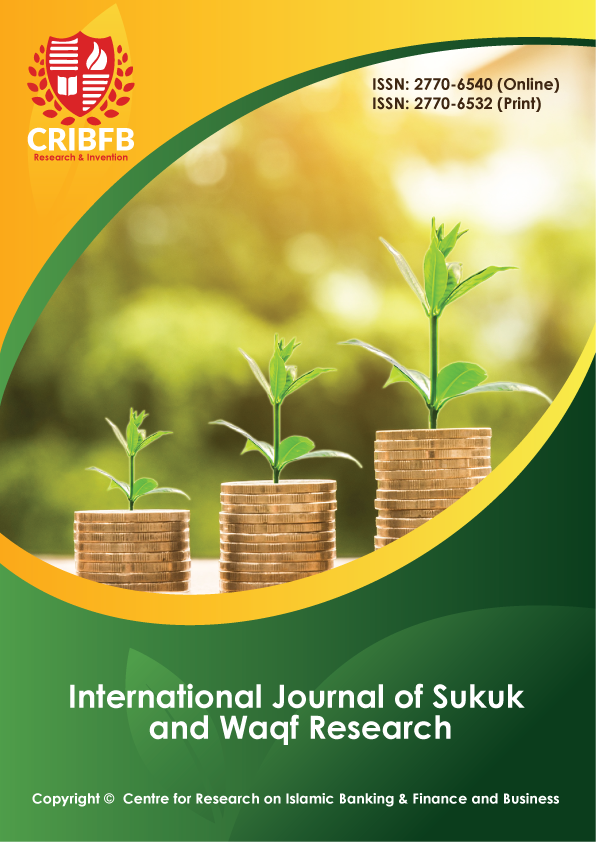A HISTORICAL OVERVIEW OF WAQF
Abstract
This research delves into the historical evolution of Waqf, an Islamic philanthropic institution with centuries-old roots. Tracing its origins to early Islamic societies, the study examines how Waqf has adapted to diverse cultural landscapes and contributed to social welfare. Through an interdisciplinary approach, it explores legal frameworks, socio-economic impacts, and the role of Waqf in shaping communities. This historical overview aims to deepen understanding of Waqf's enduring significance and implications for contemporary socio-economic structures. The main objective of this research is to undertake an overall relevance of the historical Waqf in the Islamic Economic system. It will elaborate on Waqf juristically, classically and modernly. The study explored various aspects such as Waqf's meaning, different definitions by several religious schools of thought, historical origins, and legitimacy of the Waqf based on Quranic Verses and Hadith of the Prophet (PBUH). Throughout Islamic civilization, Waqf played a vital role in Muslim society, given that the needs of the Muslim Ummah were complex and growing. The objective of Waqf is to promote social welfare and to contribute to economic development. The potential of the institution of Waqf is excellent; it can assist the government in countless state responsibilities.
JEL Classification Codes: N35.
References
Abdurrahman, S. M. (2008). Traditional and Contemporary modes advocated for revitalizing Awqaf: a Shari’ah based scrutiny. International Conference on Waqf and Islamic Civilization. Isfahan: Iran.
Ahmed, H. (2004). The Role of Zakah and Awqaf in Property Alleviation. Jeddah: Islamic Development Bank. Retrieved May 2015, from http://www.ieaoi.ir/files/site1/pages/ketab/english_book/201.pdf
Al-Hassani, M. A. (2013). The Role of Awqaf In Developing Islamic Civilisation: Definition, History, Functions And Articulations with Society. In KING ABDUL AZIZ ENDOWMENT FOR THE TWO HOLY MOSQUES (pp. 1-64). Riyadh, KSA: Desert Publishers. Retrieved May 16, 2015, from http://muslimheritage.com/topics/default.cfm?ArticleID=1448
Alias, T. A. (2011). Tax laws affecting Waqf in Malaysia: A comparison with the United Stated and Turkey. 6th UUM International Legal Conference. Pulau Penang.
Bewley, M. A. I. (2001). Zakah the fallen pillar of Islam. Cape Town, South Africa: Dar al-Hijrah.
Cizakca, M. (2000). A history of Philanthropic foundations: The Islamic World from the Seventh Century to the present. Istanbul: Bogazici University Press.
Crecelius, D. (1986). Incidences of Waqf Cases in Three Cairo Courts: 1640-1802. Journal of the Economic and Social History of the Orient/Journal de l'histoire economique et sociale de l'Orient, 176-189.
Kahf, M. (1998). Financing the development of Awqaf property. Development of awqaf (pp. 1-43). Jeddah: IRTI.
Kahf, M. (2000). Al-Waqf Al-Islami: tatawwuruh, Idaratuh, Tanmiyatuh. Beirut: Dar al-Fikr.
Kahf, M. (2014, December 16). Role of Waqf in Sustainable Development - Kinds and Objectives of Islamic Waqf. Retrieved from On Islam: http://www.onislam.net/english/shariah/contemporary-issues/islamic-themes/452483-type-goals-islam-waqf-endowment-finance-economy.html
Malik, M. B. (1994). Muatta. In I. Malik, Kitabul Wasiyyah. Dar e Ihyaul ulaoom Al Arabiyah.
Mohsin, M. I. (2014). Corporate Waqf - From Principle to Practice ( A New Innovation for Islamic Finance). Kuala Lumpur: Pearson Malaysia Sdn. Bhd.
Mohammad, M. T. S., Iman, M., & Hamid, A. (2006). Obstacles of the current concept of waqf to the development of waqf properties and the recommended alternative. Malaysian Journal of Real Estate, 1(1), 27-38.
Raissouni, A. (2001). Islamic “Waqf Endowment” Scope and Implications. Rabat, Morocco: ISESCO.
Sadeq, A. M. (2002). Waqf, perpetual charity and poverty alleviation. International Journal of Social Economics, 135-151. Retrieved from http://www.emeraldinsight.com/doi/abs/10.1108/03068290210413038
Copyright (c) 2024 Obaidullah Abid, Sarferaz Miakhil

This work is licensed under a Creative Commons Attribution 4.0 International License.





